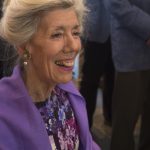
BY JUDY CARMACK BROSS
The name Demons and Doughnuts aptly captured the University of Chicago freshmen orientation event held a week after a 100th birthday gala for the Oriental Institute, showing that these days everyone wants to be in the newly renovated OI.

Centennial gala guests view a new art installation by Michael Rakowitz at the OI Museum. Photo by Anne Ryan.
Smart phones in hand, students from around the world raced through the halls created by the university’s own Indiana Jones, Egyptologist James Henry Breasted, taking photos of demons excavated in the Middle East. Just week before, 400 community leaders, scholars, and Breasted’s grandson David celebrated in the same hallowed halls, spilling out into a tent on the University of Chicago lawn.
After the freshmen departed with their doughnuts, we talked with OI President Chris Woods whose desk bears the same blotter, pen case, and excavation fragments that Breasted saw each day. A photo Woods showed us from a 1930s book pictured the office looking very much the same. Breasted’s adventurous spirit still haunts the museum and research center.

OI Director Christopher Woods (right) with Kim Duchossois. Photo by John Zich.
But so much has changed as Woods looked ahead to the next 100 years. Soon after our meeting, Woods took off for work in Iran with one of the most difficult to obtain visas, his next stop the University of Chicago’s Beijing center. Bringing the OI’s significance to a worldwide audience is a key centennial year goal.
Woods shares: “In 1919 James Henry Breasted founded the Oriental Institute with the radical idea that who we are and how we live together began not in Greece or Rome but rather in a region he vividly named the Fertile Crescent. From the outset, Breasted’s goal was to conduct ancient Near Eastern research on the scale and scope that was only possible in a robust research institute.”
“The Museum houses some 350,000 artifacts excavated mainly by OI archaeologists,” he continues. “During the last century we excavated dozens of sites spanning Tunisia to Iran. Early 20th century expeditions to Iraq, Iran, Egypt, Turkey, Syria, and Israel produced definitive archaeological data for the Middle East, from prehistory to the Islamic period. Fieldwork stands at the core of our mission.”
He says that today it is not only their transformative excavations and research projects across the area that make up this mission but also state-of-the art satellite and digital imaging laboratories aimed at the discovery of ancient settlements.
John and Jeanne Rowe, who in 2013 received the OI’s highest honor, the Breasted Medallions, served as Centennial Gala Chairs. The evening raised over $375,000.
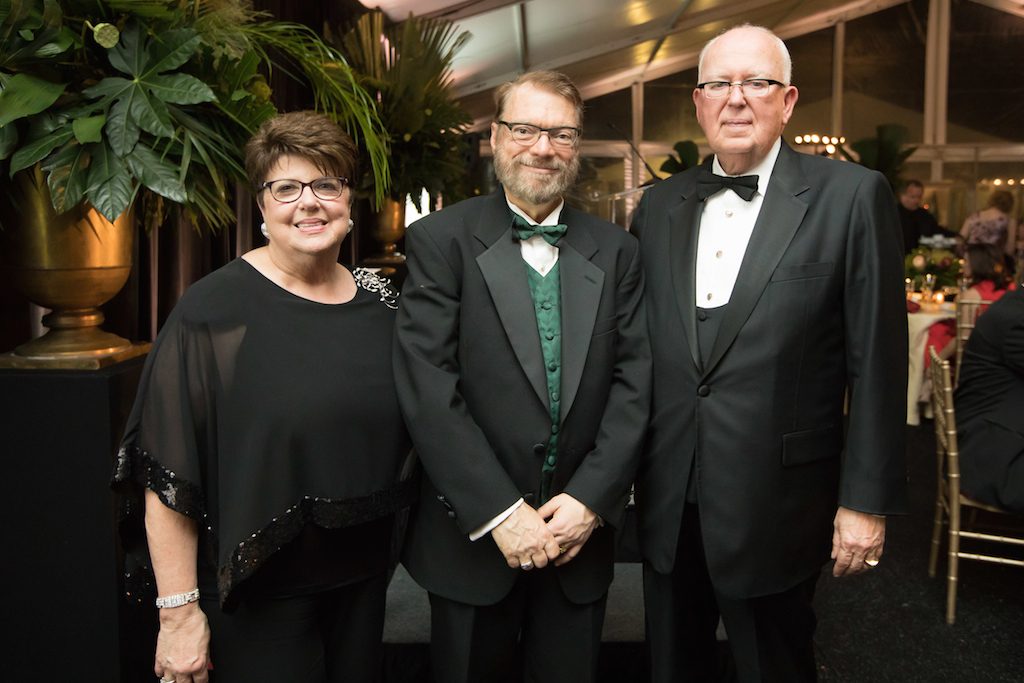
Gala co-chairs Jeanne Rowe and John Rowe with Robert Ritner (center). Photo by Anne Ryan.

Guests mingle at the reception in the OI’s Research Archives Reading Room prior to the gala. Photo by John Zich.
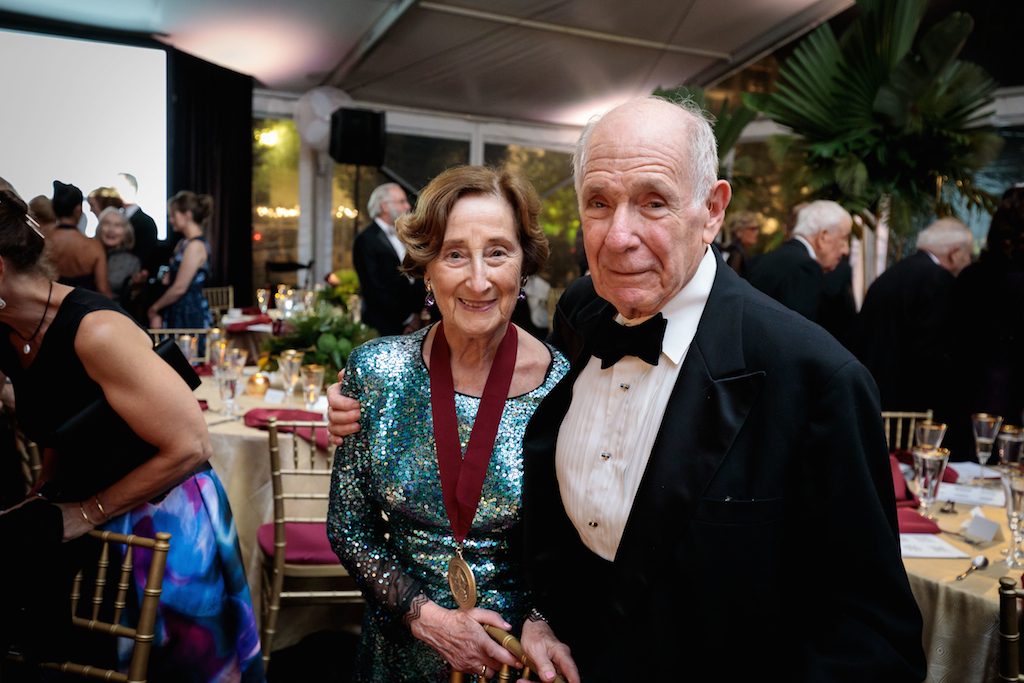
Janet and Robert Helman. Photo by Anne Ryan.
Carlotta Maher, the medallion’s first recipient in 1997, is herself a seasoned Egyptologist and hieroglyphics translator, known by many as “the goddess of the Nile.” She confessed to “casting Egyptian spells” the day of the gala to insure sunshine and, of course, they worked.
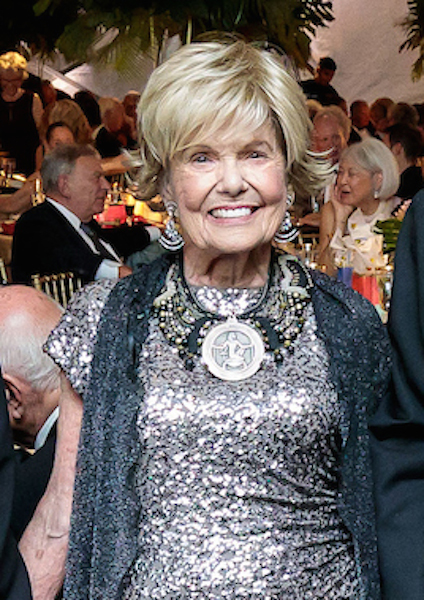
Carlotta Maher. Photo by John Zich.
A major force behind the Centennial Celebration, Maher described the gala and opportunity to view the new gallery changes completed for the museum’s 100th anniversary as “thrilling.” She shares, “The transformation is due to the generosity of Howard H. Hallengren, who received the Breasted Medallion for 2019 at the gala. We have been friends for years and my husband, David, and I mentioned to him as a throwaway line in l976 that he should come with us on an OI trip to Egypt and fell in love then and there with archaeology and the OI.”

Christopher Woods with Breasted Medallion recipient Howard Hallengren. Photo by John Zich.
“In the past when you visited the museum you were looking at world class treasures in the dark practically and now, thanks to Howard, they are spectacular to see,” Maher describes. “The galleries are now just gleaming in their new transformation thanks to lighting, new cases, and wonderful graphics that really describe what you are seeing. Before the descriptions were so arcane with mainly label numbers and accession dates. Now you know why what you are seeing is important.”
Of the evening, Maher adds, “Following the gallery tour guests walked out into the tent on the campus grounds. What a difference from the tents in Iraq and Egypt where I have been on digs.”
Jay Tunney, author of The Prizefighter and the Playwright, written about his father, boxer Gene Tunney, told us more about one of the gala’s guests of honor, David Breasted. Tunney first met Breasted 65 years ago when both lived in Southern California and were in the Marine Corps. The Tunneys and Breasteds are cousins by marriage.
“Breasted was born in Chicago, but the family moved when he was a toddler. He said the gala gave him his first visit to the Oriental Institute, and he was thrilled by the collections,” he explains. “David Breasted has given the OI several family books and an early camera used by his grandfather for his fieldwork. While touring the new OI museum galleries with me before the gala, he was captivated by a large photograph he had never seen which showed his grandfather, grandmother, and his father as a young boy in Egypt atop the uraeus, the upright Egyptian cobra which is a symbol of royalty, of Ramesses II at Abu Simbel in 1906.”
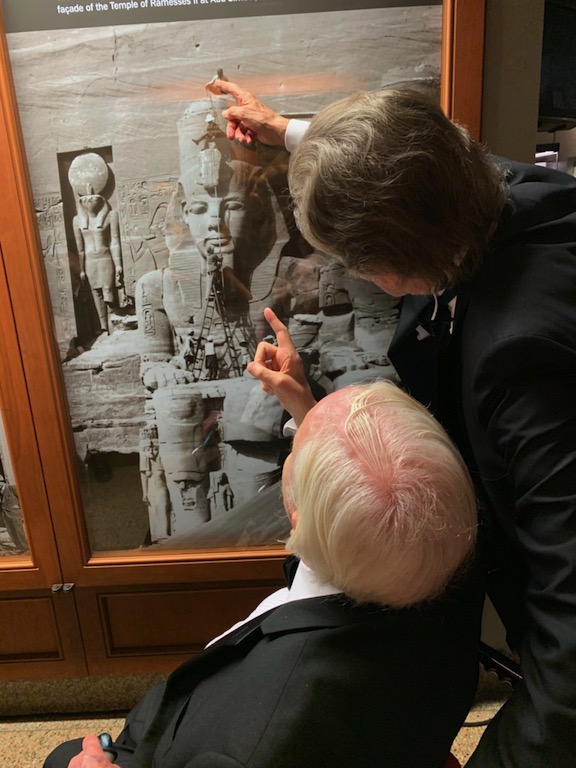
David Breasted, pictured here with author Jay Tunney, examines a photo of his grandfather James Henry Breasted on an early Egyptian excavation.
Breasted grew up in a household so dominated by Egypt and talk of excavations and history that when he was young he assumed all boys had the same knowledge, Tunney reveals. Every book of Egyptian history had a special place on the shelves, and he dared not misplace one for fear of being punished.
A graduate of Yale University, Breasted became a journalist and worked for the Washington Star and the Washington bureau of the New York Daily News, covering the White House and Congress as well as other stories. “He’s an experienced and accomplished sailor, saying that steering a sailboat upwind in light air is the closest thing he knows to meditation. Except, he said, maybe sitting atop the giant uraeus of Ramesses II,” says Tunney.

Charles Mottier and David Breasted.
No Chicago museum could possibly offer the fun and scholarship that the OI has for his centennial year. Not to be outdone by Demons and Donuts for freshmen, the Young Professionals group has planned a pre-Halloween Mummies and Martinis event, complete with a DJ, themed beverages, and small-group tours of the Egyptian galleries.
Early on, planners realized the year could not proceed without a salute to Indy, the University of Chicago’s most famous fictional student. In addition to movie screenings, the two-day event held this weekend included a panel of archaeologists, a conversation on pop culture and archaeology, and a costume contest. The 1959 film The Mummy will be shown October 26 in an OI gallery as another Egyptian Halloween salute.
On a more serious archeological note, McGuire Gibson, OI professor and one of the world’s leading authorities on ancient Mesopotamia, will celebrate the OI’s return to Iraq with a member’s evening on November 6 exploring the history of the institute’s archaeological involvement in the area.
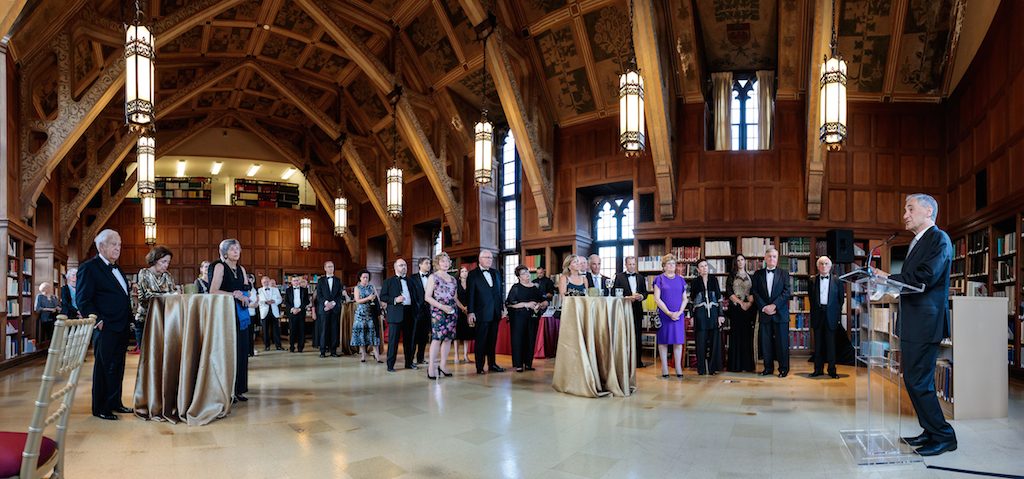
University of Chicago President Robert Zimmer addresses gala guests. Photo by John Zich.
An OI limited special edition, 100 Highlights, came out in time for the Centennial, beautifully depicting just a few examples of the institute’s assets.
Not even Indiana Jones unearthed such treasures.
For more information on the Oriental Institute and its Centennial Programs, visit oi.uchicago.edu.







